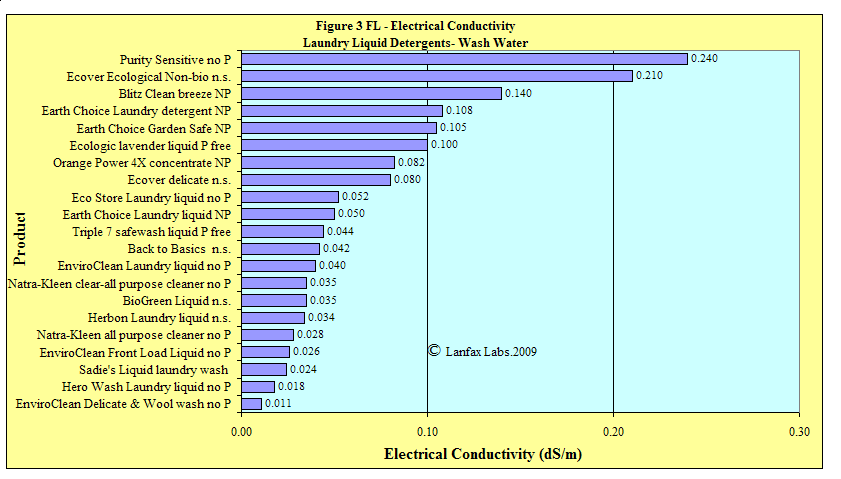Liquid Laundry Detergents
(WASH ONLY)
Liquid laundry detergents offer a convenient method of metering detergent to a clothes washing machine, that is, in a liquid form. The viscosity of the liquid varies from product to product, with low viscosity liquids being more like water and high viscosity liquid being more like engine oil or honey. Thus, how accurately we can measure the product using the cap (lid) of the liquid container will depend upon the viscosity. One solution is to throw the full measuring cap into the wash and retrieve at the end of the full wash cycle. (When I'm allowed to do the washing, that's what I do and I haven't been chastised yet!)
The liquids tested here were provided by the manufacturers after being contacted by Lanfax Labs. No charge has been made for the results provided here but also no prior reporting to the manufacturers was made before or since this information was loaded onto this website.
None of the information provided may be construed as endorsing any product, nor in any way saying that one product is more preferable in an environmental sense than any other product. The information needs to be assessed in tune with the specific circumstances that the greywater will be discharged to the garden or lawn. For this reason, you need to read the section on Greywater and Gardens before choosing one product over another.
None of these products has been tested for wash or rinse performance in any machine, hence no assessment of their washing characteristics can be given. Since wash and rinse performance depend upon hardness of water, detergent type and dose, temperature of the water as well as the performance capability of the particular washing machine (see Washing Machines) and the dirtiness of the clothes (as well as type of material), it is not possible to provide an evaluation for all configurations.
Select the product that best suits your environmental requirements. Based upon the same criteria as set out at the bottom of page Greywater, all the products when mixed for both front loader and top loader wash cycles (only the wash component of the cycle, not including the rinse) meet all the criteria.
Liquid laundry detergents differ significantly from the powder detergents in that liquids all have pH values less than 10.1, total dissolved solids (TDS) less than any of the powders, only one of 21 products had phosphorus above 0.1 g/wash, and all values for sodium were lower than the lowest of the powders. While the organic components may have some dispersive effect upon the soil, the problem of sodium interaction with soil and plant environments is not an issue on average size gardens.
The recommended dose of detergent was mixed with deionised water (equivalent to good quality rainwater), shaken for 20 minutes at 20oC, then analysed for pH, EC, TDS (by calculation), total alkalinity, boron, potassium, sodium, phosphorus and sulphur. None of the products had boron greater than 1 mg/wash.
The following sections are set out with the graphs of the front loaders first, followed by the section on top loaders.
Rinse only water from any of the products listed below will be significantly less than the values reported here, because only the residue that remains in the clothes is added to the rinse water. Depending upon the quality of the input water (rainwater, town water or bore water), values for rinse water are generally safe for garden application. Previous research in collaboration with Choice confirmed the very low levels of residue detergents in rinse water.
FRONT LOADER rates of Liquid Laundry Detergents, mixed for 25 L per wash cycle
Electrical Conductivity - values less than 1.0 dS/m are mostly suitable for irrigation. All front loader wash water is below this value. Depending upon the source of the input water, EC values for the combined wash and rinse water may be less than reported below.

pH Values between 6.5
and 8.0 are within the range of normal biological processes. However, powder
detergents are mostly above 10.6.
The pH value of the deionised water was 5.6. Depending upon the source of the
input water, pH values for the combined wash and rinse water may be less than
reported below.

Sodium and Phosphorus - only
one product had phosphorus above 1 mg/wash. The industry standard for
powder laundry detergents is 7800 mg/wash.
Where wash and rinse water are mixed prior to land application, the load of
sodium and phosphorus does not change.

Washes per litre - use this graph to help calculate the price per wash, based on the recommended dose for a 'normal' wash

The values in the graphs below are for the wash cycle only. Where both the wash and rinse waters are combined before application to the garden, pH and EC values may be lower, depending upon the quality of the input water. The rates for sodium, phosphorus and sulphur are given in grams per wash and remain unchanged if all the water is combined. When only the rinse water is used for irrigation, the quality of the rinse water is close to that of the input water.



The number of washes per kilogram is based upon the recommended dose as set out on the packet.
